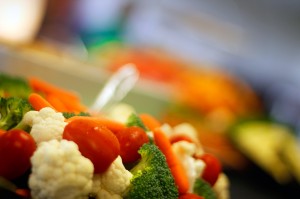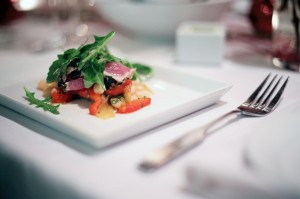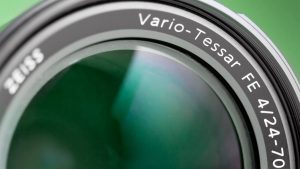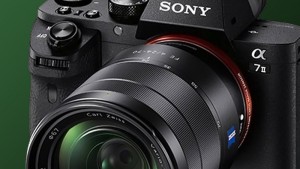Plenty of us snap a pic of what we’re about to eat with our smartphones, but taking a well-composed shot that’s worth printing is a very different undertaking. Food photography can be as challenging and rewarding as human subjects. Here are my top six tips to get great-looking food in photos and video.

1. Start with good, fresh food. This may seem obvious, but you’re not going to get a great shot of a dried-out pizza. Use fresh ingredients, a good chef, and have the tools you need to cook nearby. You want to be able to go from the grill/oven/fryer to the lights in as few steps as possible.
2. Bring at least five times the ingredients you need for a single entree. I suggest starting by making the entree once just as a sample, before you even take out the camera. Get an idea for the color, the shape, the texture. This is your chance to play with light and plating.
3. The background is the context for your work. Is the product fast-casual? Upscale? Infinite white may work great for fast food photography, but it’s usually too dry for fine-dining work. Build a set for your food after you see how the first sample comes out. If the emphasis of the food is on the origins, consider including the ingredients in the background, like wheat behind a fresh-baked loaf of bread, or an orange behind your delicious glass of orange juice. If the emphasis is on the mood and ambiance of the restaurant, try shooting in a table setting. If the emphasis is on the culture of the food, try to connect it to the people or the place it comes from.
4. This is macro, be prepared. You’ll want a close-focusing lens that can be stopped down if necessary. If you’re shooting video, try adding very slight motion. A tabletop dolly and a high framerate will give you extra-smooth motion, especially if someone in your shot is pouring, cutting, or moving the food.

5. Lights matter, and you may need more than you think for high framerates, fast shutters, and control of focus in macro. Three-point lighting usually works for opaque foods, but remember that the heat from tungsten lights can dry out or melt the product. For stills, flash is definitely the way to go. For video, I like to use natural light when possible, but Kino Flo banks and other fluorescent fixtures are a good option, too. Avoid cheap LED lights, they tend to shift colors in odd and unpredictable ways. Big softboxes may have a tendency to flatten out textures, since they are many times bigger than the subject they are lighting. Often, semi-soft or hard key light is the best option for food shots. Pay special attention to reflections and highlights on polished and wet surfaces.
6. Every great photograph tells a story, and food is no exeption. Think of one brief thought you’d like your audience to have when they see this shot. Is the picture making your mouth water? Does it invoke the emotion you’re trying to convey? That’s how you know you’ve got the shot you want.
Thanks to Bleu for the delicious tuna! Now, go find some food, take some shots, and dig in!
Posted by Jon Kline




